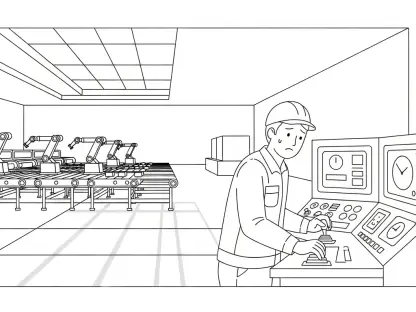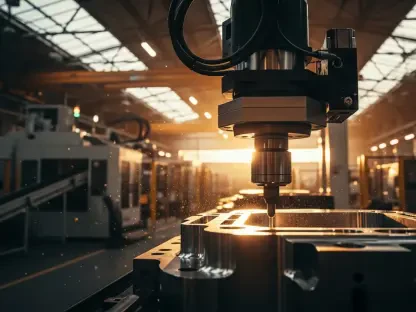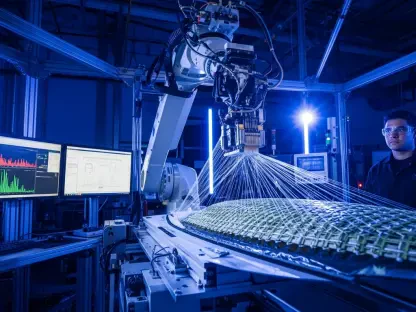The manufacturing industry is undergoing a significant transformation driven by the rapid adoption of robotics and artificial intelligence (AI). These technological advancements are not only enhancing production processes but also redefining the future of manufacturing. As we delve into the various facets of this evolution, it becomes evident that the integration of robotics and AI is pivotal in shaping a more efficient, secure, and sustainable manufacturing landscape.
The Rise of Advanced Robotics in Manufacturing
Revolutionizing Production Processes
The integration of advanced robotics in manufacturing is revolutionizing production processes. In the U.S. automotive sector, for instance, the adoption of cutting-edge robotics has significantly improved efficiency and reduced costs. These robots are capable of performing complex tasks with precision, leading to enhanced overall performance. The transition into the Fifth Industrial Revolution (5IR) is marked by these technological advancements, signaling a leap forward from the Fourth Industrial Revolution (4IR). As robots take on more sophisticated roles on the production floor, they not only increase productivity but also ensure consistency in output quality.
Advanced robots, equipped with AI, can seamlessly collaborate with human workers, creating a synergistic work environment that maximizes strengths on both sides. This collaborative approach allows for continued agility in manufacturing settings, adapting quickly to new production requirements or unexpected disruptions. The importance of these advancements cannot be overstated as they enable manufacturers to stay competitive in a fast-evolving market, adapting swiftly to consumer demand and technological changes.
Enhancing Efficiency and Reducing Costs
Advanced robotics are not only transforming production processes but also enhancing efficiency and reducing costs. By automating repetitive and labor-intensive tasks, manufacturers can achieve faster production times and minimize human error. This shift towards automation allows companies to allocate resources more effectively, ultimately leading to cost savings and improved productivity. As machines take over mundane tasks, human workers can focus on more complex and value-added activities, leading to a more streamlined and agile manufacturing environment.
Automation also facilitates better utilization of materials and energy, improving overall sustainability. With robots operating around the clock, downtime is reduced, and production output is maximized. Furthermore, predictive maintenance enabled by AI helps anticipate mechanical failures before they occur, minimizing unplanned stoppages and extending equipment lifespan. The infusion of robotics into manufacturing workflows signifies a move towards a more dynamic, efficient, and cost-effective production paradigm, poised to meet the growing demands of the modern marketplace.
Improving Overall Performance
The implementation of advanced robotics in manufacturing is also improving overall performance. These robots are equipped with sophisticated sensors and AI algorithms that enable them to adapt to changing conditions and optimize their operations. As a result, manufacturers can achieve higher levels of precision and consistency, leading to better quality products and increased customer satisfaction. For example, in sectors where precise measurements and immaculate hygiene are crucial, such as pharmaceuticals or food processing, the meticulous operations performed by robots guarantee adherence to stringent standards.
Moreover, the data collected by these robots provide invaluable insights into the production process, highlighting areas for improvement and driving continuous operational enhancements. This data-driven approach ensures that manufacturing processes are constantly refined, leading to ongoing improvements in performance. The benefits extend beyond production, impacting various facets of the business, including supply chain management, logistics, and inventory control. With enhanced operational efficiency and product quality, companies can strengthen their market position and build greater trust among consumers.
The Critical Role of AI in Manufacturing
Predictive Maintenance and Operational Efficiency
Artificial intelligence is playing a crucial role in predictive maintenance and operational efficiency. Machine learning algorithms can analyze vast amounts of data to predict equipment failures and schedule maintenance activities proactively. This approach not only reduces downtime but also extends the lifespan of machinery, resulting in significant cost savings for manufacturers. The predictive capabilities of AI mitigate the risk of unexpected breakdowns, thereby ensuring uninterrupted production and minimizing financial losses associated with downtime.
For example, sensors on production equipment collect data in real-time, and AI systems evaluate this information to identify patterns and predict potential issues. By addressing these issues before they become critical, manufacturers can maintain a high level of operational efficiency. This proactive maintenance strategy not only improves equipment reliability but also enhances overall productivity. Additionally, AI-driven predictive maintenance helps in optimizing inventory for spare parts, ensuring that essential components are available when needed without holding excess inventory that ties up capital.
Enhancing Supply Chain Management
AI is also enhancing supply chain management by providing real-time insights and improving demand forecasting. Accurate demand forecasting is essential for maintaining optimal inventory levels and avoiding stock shortages or excesses. AI-powered supply chain solutions enable manufacturers to respond quickly to market changes and ensure timely delivery of products. With AI algorithms sifting through data from various sources, supply chain managers can gain a comprehensive view of the entire supply chain, identifying potential bottlenecks and implementing corrective actions promptly.
Furthermore, AI-driven analytics can optimize routing and logistics, reducing transportation costs and improving delivery times. By leveraging AI’s predictive capabilities, supply chain managers can better anticipate disruptions and develop contingency plans, ensuring that operations remain smooth and efficient. The integration of AI in supply chain management fosters a more resilient and adaptive network, capable of withstanding market volatility and meeting customer expectations more consistently.
Facilitating Smart Manufacturing
The concept of smart manufacturing is becoming a reality with the integration of AI. Smart factories leverage AI to optimize production processes, monitor equipment performance, and ensure quality control. By harnessing the power of AI, manufacturers can achieve greater flexibility and adaptability, allowing them to meet the evolving demands of the market. AI systems can analyze production data to identify inefficiencies and recommend process adjustments, ensuring continuous improvement and high-quality output.
Moreover, AI facilitates advanced automation and connectivity within smart factories, enabling seamless communication between various systems and devices. This interconnected environment enhances coordination and collaboration, leading to more efficient and effective operations. As manufacturers continue to adopt AI-driven smart manufacturing solutions, they can unlock significant competitive advantages, including increased agility, reduced operational costs, and improved product quality. The shift towards smart manufacturing underscores the transformative potential of AI in driving the next generation of industrial innovation.
Securing Future Operations with Zero Trust Network Access
The Shift from VPNs to Zero Trust
As cyber threats continue to evolve, manufacturers are rethinking their security strategies. The shift from traditional virtual private networks (VPNs) to zero trust network access is a significant corporate decision aimed at securing future operations. Zero trust practices ensure that only authenticated users and devices can access the network, providing a more secure and resilient business framework. Unlike VPNs, which grant broad access across the network, zero trust adopts a more granular approach, verifying identity and permissions at every access point.
With the increasing reliance on connected devices and automation, ensuring robust cybersecurity measures is critical for protecting sensitive data and maintaining operational integrity. Implementing zero trust network access reduces the attack surface, making it more challenging for cybercriminals to infiltrate the network. This approach also supports remote work and IoT integration, aligning with the modern manufacturing landscape’s need for flexibility and scalability.
Enhancing Cybersecurity Measures
Zero trust network access enhances cybersecurity measures by continuously verifying the identity of users and devices. This approach minimizes the risk of unauthorized access and data breaches, safeguarding sensitive information and critical infrastructure. As manufacturers adopt more connected and automated systems, robust cybersecurity measures become increasingly important. The zero trust model operates on the principle of “never trust, always verify,” ensuring that authentication and authorization processes are applied consistently across all network interactions.
This constant vigilance helps in identifying and mitigating potential threats before they can cause damage. Additionally, zero trust frameworks can integrate with AI-driven threat detection and response systems, providing real-time monitoring and swift action against any anomalies. By bolstering cybersecurity defenses, manufacturers can protect their digital assets and maintain the integrity of their operations. This proactive stance on security is vital in an era where cyber threats are becoming more sophisticated and pervasive.
Ensuring Business Continuity
Implementing zero trust network access is also crucial for ensuring business continuity. By protecting against cyber threats and maintaining secure network access, manufacturers can avoid disruptions and maintain smooth operations. This proactive approach to cybersecurity is essential for sustaining long-term growth and competitiveness in the manufacturing industry. In cases where a breach does occur, zero trust can limit the spread of the attack, containing the damage and allowing for quicker recovery.
Moreover, zero trust frameworks support compliance with various regulatory standards, ensuring that manufacturers meet legal and industry requirements for data protection. This compliance not only protects the company from legal repercussions but also builds trust with customers and partners. As the manufacturing sector continues to digitalize, adopting robust and forward-looking security measures like zero trust network access is imperative for safeguarding the future of the industry.
Developing Skilled Labor for the Future
Addressing Labor Shortages
The development of skilled labor is a pressing challenge in the U.S. manufacturing sector. Reshoring efforts, impending retirements, and evolving skill requirements driven by technological advancements have led to labor shortages. Manufacturers are prioritizing attracting and retaining talent to maintain competitiveness in the global market. As industries become increasingly automated and reliant on advanced technologies, the demand for workers proficient in these areas grows. This shift necessitates a focus on education and training to bridge the skills gap and ensure a steady pipeline of qualified candidates.
Efforts to address labor shortages include partnerships between manufacturers and educational institutions, offering apprenticeships, and on-the-job training programs. These initiatives aim to equip workers with the necessary skills to thrive in a modern manufacturing environment. By cultivating a workforce skilled in robotics, AI, and other advanced technologies, manufacturers can better navigate the challenges of the evolving industry landscape and secure their future growth.
Strategic Training and Development
Strategic training and development initiatives are crucial for equipping the workforce with the necessary skills to handle advanced manufacturing technologies. By investing in education and training programs, manufacturers can ensure a ready workforce capable of adapting to new technologies and processes. This approach not only addresses labor shortages but also fosters innovation and growth. Comprehensive training programs that cover both technical skills and soft skills are essential for developing well-rounded employees who can contribute effectively to the organization’s success.
Moreover, continuous learning opportunities and career development pathways encourage employee retention and engagement. By offering clear advancement prospects and supporting lifelong learning, manufacturers can attract top talent and reduce turnover rates. Investing in the workforce’s development also signals a commitment to employees’ growth and well-being, creating a positive work environment that drives overall productivity and morale.
Bridging the Skills Gap
Bridging the skills gap is essential for sustaining a stable workforce and invigorating the U.S. manufacturing industry. Policies and initiatives that focus on transitioning workers from low-paying jobs to professional careers in manufacturing are vital. By providing opportunities for skill development and career advancement, manufacturers can build a resilient and capable workforce. Programs that focus on upskilling and reskilling workers play a crucial role in this transition, helping individuals acquire the competencies needed for higher-paying and more technical roles.
Collaboration between government, industry, and educational institutions is key to creating these pathways. Effective training programs should be designed with input from manufacturers to ensure they meet the industry’s evolving needs. By addressing the skills gap proactively, the manufacturing sector can secure its future workforce and remain competitive in the global market. This concerted effort to develop talent not only benefits individual workers but also strengthens the overall economy by creating a robust and dynamic manufacturing industry.
The Impact of U.S. Elections on Global Trade
Shaping Trade Policies
U.S. presidential elections have the potential to shape global trade policies and economic relationships. Election outcomes can lead to shifts in trade policies, impacting the supply chain landscape and international economic dynamics. For instance, a resurgence of protectionist measures might be adopted, aiming to reduce reliance on major trade partners like China. These shifts can have far-reaching implications, altering trade agreements, tariffs, and regulations that influence the flow of goods and services across borders.
Changes in leadership often bring new priorities and strategies, with implications for foreign trade and investment. Manufacturers must stay vigilant and adaptable, responding to policy changes that may affect their operations. Strategic planning and diversification of supply chains can help mitigate risks associated with such political shifts. By staying informed and agile, manufacturers can navigate the complexities of global trade and maintain their competitive edge.
Redefining Supply Chain Dynamics
The manufacturing industry is experiencing a major transformation due to the rapid adoption of robotics and artificial intelligence (AI). These cutting-edge technologies are significantly improving production processes and are redefining the entire future of manufacturing. By examining the numerous aspects of this evolution, it becomes clear that the integration of robotics and AI is essential for creating a more efficient, secure, and sustainable manufacturing environment. Not only do these advancements streamline operations, but they also enhance quality control, reduce human error, and maximize productivity. Moreover, AI-driven analytics provide valuable insights into optimizing resource usage, thereby promoting sustainability. Robotics, on the other hand, ensures high precision and speed in repetitive tasks, leading to increased output and reduced costs. As companies continue to innovate and adapt to these technologies, the manufacturing sector will see a profound shift towards smarter, greener, and more resilient practices, marking a new era for the industry.









